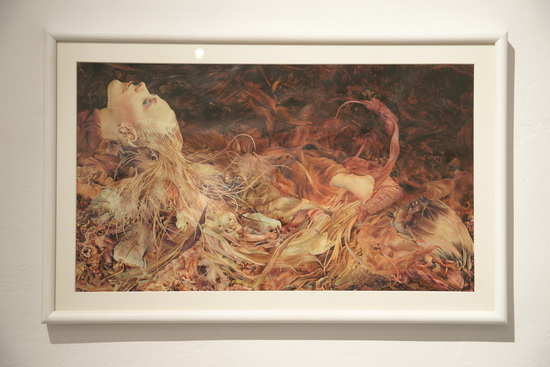KONRAD MACIEJEWICZ Afrodit
Opening: 16.11.2012, opening hour: 18.00
Open until: 7.12.2012

Therefore, before determining what Maciejewicz’s artworks are, it is worth reflecting on what they are not. First impression may be deceiving since they are not paintings. Yet, seeing the framed artworks, it is no surprise that we perceive them as carefully painted scenes, at least until we come closer and our vision sharpens. The illusion of a painting surface – the spell that we unknowingly fall under – may be explained twofold. First of all, the material used by the artist has a painterly quality. Elements that form these visual structures have been taken directly from women’s magazines from the 1960s, 70s and 80s, which Maciejewicz purchases in large numbers to transform cut-out pieces of different shape and size into abstract and figurative images.
In my opinion, however, it is not the specific character of the old print that made the artist use this particular material. Difficult to capture, the colour value of these often faded reproductions is superseded by bizarre and ambiguous stories hidden behind the surface. Aesthetic predilections of the artist revealed in the nostalgic reference to the distant past are eclipsed by the power of curiosities and wonders lurking in the shadows of the images. Fortunately, the ultimate horror of transformed magazines liberates us from conjecturing that the above is only a superficial strategy. Whether Maciejewicz wants it or not, there is a retro feel present in his artwork, which, however, appears to be of little significance. On the other hand, what seems to be very important is the direction itself – a vector pointing the past. Its final point is not in the 1960s though. Nevertheless, there is no doubt that the cutouts contain reminiscence of the past imprinted in them by means of a heartless printing press. What is more, they reflect the passage of time that deprived them of colour saturation.
More important than the nostalgia for the time that passed is the moment when these scraps of paper find their way to the artist’s studio. At this point the second element creating an aura effect might be noticed. Mass-reproduced images are transformed into “paintings” made with human hands and the result corresponds with what Walter Benjamin wrote at the beginning of the 20th century: works of art by Konrad Maciejewicz come in firm opposition to the age of mechanical reproduction. Going against the mainstream of visual culture, Maciejewicz spends hours on browsing through pages of magazines to cut out pieces that captivate him.
In my opinion, Maciejewicz’s artistic journey originates from yearning for authenticity. It seems as if ephemerality of fading print was to build the reality which is closer to the artist’s idea on the truth about continuity of life, despite the fact that it is disfigured; “that in what passes there grows and is preserved something which does not pass away; that in the impermanence of events there is a growth of significance which is not directly perceived; that therefore decomposition and destruction affect only visible layer of existence, without touching the other, which is resistant to decay” [L. Kołakowski, The Presence of Myth, p. 18]. Below the visible layer there is a layer of existence vibrant with life and resistant to “fading”. It is revealed in almost mythical scenes of jealousy, sex, devourment, or – in other words – transformation.
Piotr Pękala


















